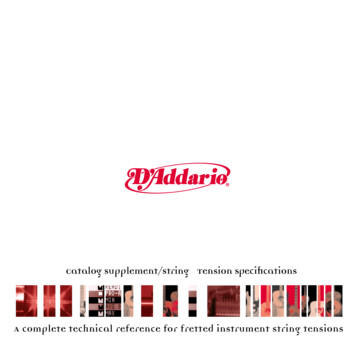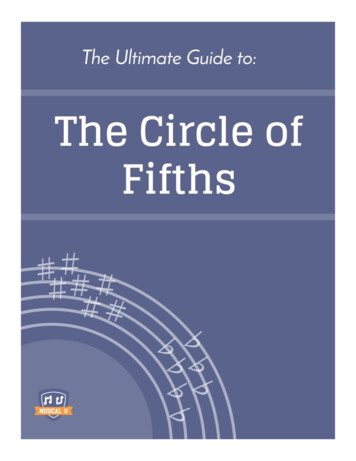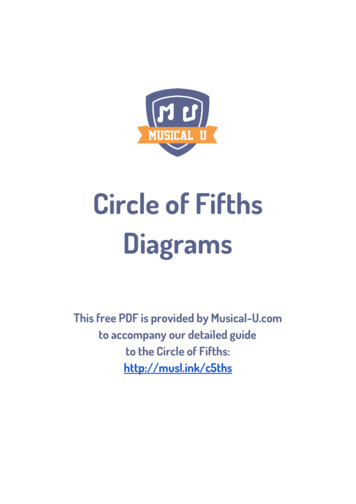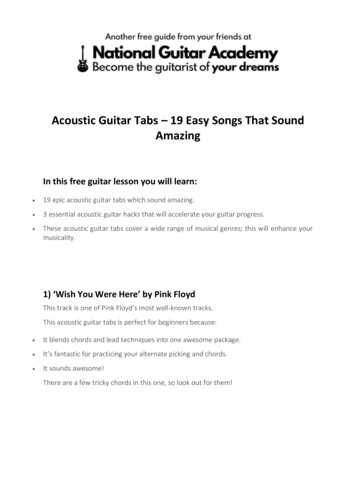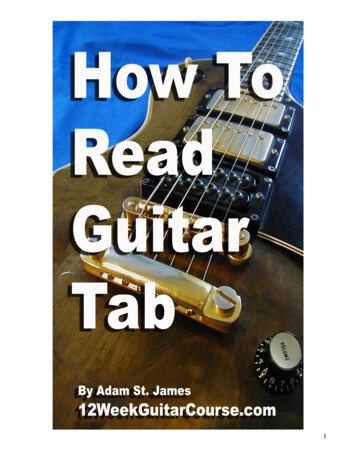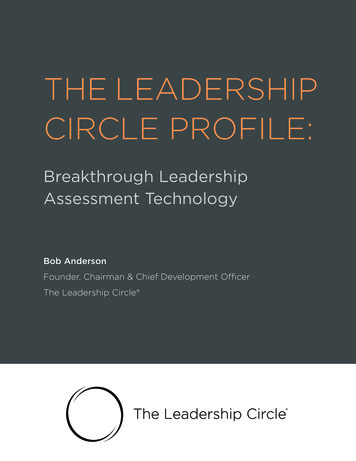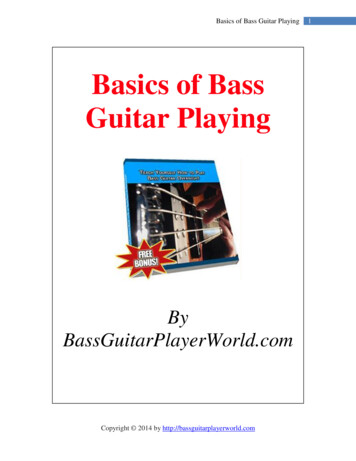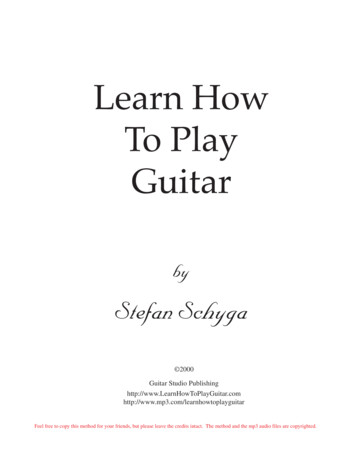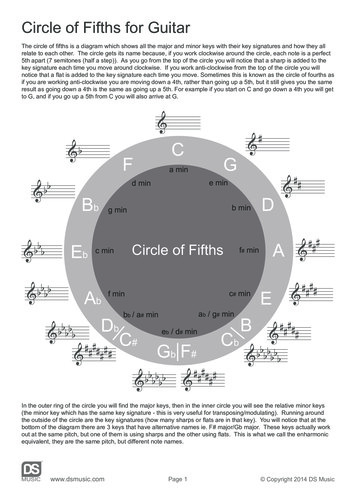
Transcription
wwwwwwww####& #Circlew###n#wwwnwwwww # ww# # ww&www Guitarof Fifths forwwwbwwnwww#### # &# #n#wwwww # w n ww# # wwwwww#w#w&& #The circle of fifths is a diagram which shows all the major and minor keys with their key signatures and how they allrelate to each other. The circle gets its name because, if you work clockwise around the circle, each note is a perfect5th apart (7 semitones (half a step)). As you go from the top of the circle you will notice that a sharp is added to thekey signature each time you move around clockwise. If you work anti-clockwise from the top of the circle you willnotice that a flat is added to the key signature each time you move. Sometimes this is known as the circle of fourths asif you are working anti-clockwise you are moving down a 4th, rather than going up a 5th, but it still gives you the sameresult as going down a 4th is the same as going up a 5th. For example if you start on C and go down a 4th you will getto G, and if you go up a 5th from C you will also arrive at G.wbwwwwww # bw#bwww#www## # ## &# ## n#wwwww n ww n wwwnw&ww&wwww#ww # ##ww # &w#ww&w wwbwwwbwwwbww n bwwwwww n bw&wwwbwbwwwww bwww&&wwwwwwwww n &www n n wwww n ww&wbwbww&&wwbwww&wwwwwwww # w# # nw#ww## n wnwwwww&wwwwwwwwwwww # wwww n w&&w&wwbw&w&bwbwbwwww # b#C b wwwwwwww # bw##wbwbwwwwwbwww#wwwwww #w # #www # # ##w&w # ww#wbwwww&&wFGwwwamin& #www# w w& & wnw&ww&ww#ww#nw # #nw#wwwwww d min# &&bww # e min#ww # w#wwbwwwbwbbww&w n wwbw&wbwwwbbww n wb&w n &&wwwwww w##nwww## # ##nwnwwww # nwwwwwwww # nw#wwwn#nw#www&w#n#wwwwwbminBb g minDwwww&&w w# # ww#w# # # ww&w#www # www#nwwnwbwwwww&nwbwwww&&www&wwbwww#w n w## # w # # n wbwwwnw#ww#ww###&wbbb &wwbww&wwwwwbw n #w # ##www w&bbbb & w w w&wwnwbwww&wn#wbwbwwbwwwn ww# n bwwwbww # nnwnwnwbwwbwww#wwwwww#w # ww n wwbwnbw#ww#wwwwwwb n bbww n wwwwbwbwww#& b b bbbbbb w#wwwwwwbww bw#ww # n bwww##wwww# # # n n &#&#wwwwbw#w # n #&wbb n ww# w# n &Circleof&&Fifthswww #&### w w# n & b& EwbAwwww&wbw&bwwwwbwbwb&w#nw#nwn ww#b# # &## b#ww # wbb &bb w###&wwwnw#wwwwwbwbwwwwww# n # &w&bwbwww&bwwwwwwbw n bwwwww&bwwwwww n w n bwbwwbbwwwwwwwbbb bbbb b#w##b wwww # wwnwwnww# n ww n wwb bb bbbb b wb b bw## # # ## nwwwww n n ww#www n wbwwnw&wwwwwbw#www # bwnww&&wwww##nnw#wb#bww#bw#nw n ##ww&w## w nww#######ww# # c# wwww # w&bbbbb& b bwbbwb& w # # & # w&w&wminwwwf minw&w&wwww#n wwwbbww&wbwwbwb&&wb#ww&&wbww n #wnw#w n wAb #b b b &wb b # bw#Eww ww###&wwwww&### n#ww#ww n nw#w#wwbwwwbww#w # wb##&wbw&&ab / g# minwbb / a# minw w w& bbbwwwwbbbbwbwwwwbwbw n b#wbwbwwbwbww#w n w n bwwwbbb b #wwbwwbwww#### # #### nw& b bbbbbbbbb bbwb bbww n ##minnwwb&w # wwwwbb bbw&wwwww&bw&w n n#wBww n w n Dbw##ww#ww n wwwnww###wbwweb/d#wbwwbbw#w&b#www# # #wnw w#wbww&&bbwww#nwnw#w&&wwwb#w&bw#wn#w##wwww n #w&w n w#wwwwwbw # w###n w# ww# n ##w # # wbbbb w&wwww&w&w# # # wwwC# bwbw wnwwb&&wwwwwbnwb#bbbbCwwwww#& b wbw##ww#w#&#w # wb#wwnww wb#bb##b &&# #www b www#w ## #wwww ww # w#wwbww& w wwF#Gbw&wwwwbw& n w wwbwwbwwwww n w n www n n wwbwwnww n bbb bbbbbbbb#b #wwwwww # wwwwwn#wwwnwwwww n n b#ww#& b bbbbbbbbbbbbbbbbbb wb b ww#nwwb#ww#w w#wwww&www# # &bwnw#wb#wwnwnw#w##www&bwwww#w#####w###### n ##w#w# # nww&bbb&w # wb b&## # # # w n ww&bbb b bww#& # #w # # ww&ww&#wwbwwwwb&#ww wb#b wb#ww##bw&b&bw##&&wbwb#w b &w b wb b bwww#### ## &##### nww w& b b bwwwb& n b ww### # wnwwwwwwww#wb#w&&w w ww &wbbb bwww wbb wwwbwwbwb b b wbwwbw## inwwringbof thewillfindmajorbkeys,circleyouwillsee the relativekeyswbbbbb#thenwwwb the b b #innerw b wwwyou& In(thebtheminorw##minor b &w the w## #nwb&ww#then# b wbwww#wbbwbwwb#w#wwbwbwwb b modulating).Runningaroundw # nwbw##w b bww##w&bw#w w####www# # w#bw b ##wwthe outside of the circle are the key signatures(howsharps#orflatsareinthatkey).Youwill # noticethatat the ww # #&wb bmany###www # #w##&w # ##ww&w#nwbww#w&&www#w&www# n #workwbottom of the diagram there are 3 keys that have alternative names ie. F# major/Gb major.w These keys&wactually# w n wwwbone of thembwwwout at the same pitch, butis using wsharps and the other using flats. This is whatwe call thebenharmonicwbbww n &&&wwequivalent, they are the same pitch, butwdifferent note names.wwwwww n wwwwwww wwww n wwwwwbwwwwwwwwb n b&www n n w n &b&wwww w &w n&bbb & b&&bbwb n w&bbwbw n wwwMUSICPage 1www.dsmusic.comDS wMusicw& b Copyrightw& 2014wwwww wbbw n wwbwww&bw b bwwbbb ww bb &bbbbbwwwbw bwwwww n bwww &ww b wwR
Circle of Fifths Guitar Chord ChartHere is a diagram of the circle of fifths complete with guitar chord diagrams and the relative minor keys.x12x x31 1213x1Bbxx13Db ming min12xEb2 3 4xe minx143Ga mind min2 3 46CFx2Ab1 124xx12 3 4ab / g# minbb / a# minC#eb / d# minCbGb F#Af# minEc# minf minDb3 4Circle of Fifthsc min1 2 312 3Bxx1x x2 3 41 123KeyFinger number & placement on stringDo not play this string1xOpen string - play string with no fingers11 1Place finger flat across (barre) the stringsRMUSICwww.dsmusic.comPage 2 Copyright 2014 DS Music
Circle of Fifths Guitar Chord ProgressionsThe circle of fifths is really useful for finding the primary chords I, IV & V in a key. Working clockwise, if you pick anykey and find it in the circle, this is your chord I, then the note before it is your chord IV and the note after it is chord V.This works for both major and minor keys. For example:E majorb minor- Chord I E,- Chord i b,Chord IV A,Chord iv e,Chord V BChord V F#Using this chart choose any major key and workout chords I, IV and V in that key, then find the3 relative minor chords and play around withmoving between these 6 chords - they should allwork really well together. For example in the keyof C, try using C major, F major, G major, a minor,d minor & e minor. You could also use these fortransposing within a composition because thesewould be the most popular new keys to move toand then when you are in your new key then youwill get your new set of I, IV & V.CFd minBbGa mine minb ming minCircle of FifthsEb c minbb / a# minDbC#ab / g# mineb / d# minGb F#Af# minc# minAb f minDCbEBThe circle of fifths is also very useful if you are using a lot of chord V to chord I chord progressions (or even dominant7th chords), because if you are playing a chord I, then all you have to do to find the chord V is move forward one(clockwise) on the circle. For example if you were playing a chord I in D Major, so a D chord, then to find your chordV, move forward one around the circle to A, this would be your chord V. This also works vice versa. If you are on achord V and want to find chord I simply move back one on the circle, so if you were playing a B chord and this wasyour chord V, then to find chord I move back one in the circle to E.It is also really easy to find a ii-V-I chordprogression (this is a very common chordprogression). If you take any 3 notes next to eachother, then take the last one and workanti-clockwise then they are the 3 chords for yourii-V-I progression, with the last chord (chord I)being your key. This example is the ii-V-Iprogression for Bb major:iiVCFId minBbGa mine minb ming minCircle of FifthsEb c minDbRMUSICwww.dsmusic.comPage 3bb / a# minC#ab / g# mineb / d# minGb F#Af# minc# minAb f minDCbEB Copyright 2014 DS Music
Using the Circle of Fifths to find Guitar Scales1There are many patterns, sequences andrelationships in the circle of fifths. Let’s take themajor pentatonic scale. If you are working out themajor pentatonic scale from the major scale theconstruction is 1, 2, 3, 5, 6 .so to work outC major pentatonic, we would use C major anduse the construction just mentioned which givesus the scale - C, D, E, G, A - now let’s look atthis on the circle:Fd minBb4Ca minDbThis gives us G, A, B, D, E as the scale for theG major pentatonicC#ab / g# mineb / d# minGb F#d minCba mine minCircle of Fifths4ab / g# mineb / d# minGb F#Af# minEc# minbb / a# minC#BDb minAb f minDb3Gg minEb c minE51CFAf# minc# minbb / a# min2Db minCircle of FifthsEb c minBbe ming minAb f minNow you know the pattern you can simplytranspose this by using the same pattern, butstarting on the new tonic (1st) note. So let’s tryusing the same pattern to work out G majorpentatonic:GCb25B3RMUSICwww.dsmusic.comPage 4 Copyright 2014 DS Music
2You can use this method with any type of scalereally, as long as you know one version of the typeof scale and then repeat the pattern starting on thenew tonic note. How about the minor pentatonicscale. If you are working out the minor pentatonicscale from the major scale then the constructionis 1, lowered 3, 4, 5, lowered 7 (the lowered notesare lowered by half a step/semitone). So if youwere trying to work out ‘a minor’ pentatonic youwould use the A major scale and the constructionas previous and you should get: A, C, D, E, G - ifwe put this pattern on to the circle the patternwould look as follows:Fd minBb5Ca minGe ming minCircle of FifthsEb c minbb / a# minC#ab / g# mineb / d# minCbGb F#Af# minc# minAb f minDb3Db minE14B35FSo let’s apply this pattern to g minor pentatonic:This gives us G, Bb, C, D, F for the g minorpentatonic scale.2d minBb1Ca mine minb ming minCircle of FifthsEb c minDbbb / a# minC#ab / g# mineb / d# minGb F#Cb4DAf# minc# minAb f minNote:GEBThe minor pentatonic scale contains the same notes as it’s relative major pentatonic, but starting on theminor key note. For example:C major pentatonic C, D, E, G, A, then the relative minor is a, and a minor pentatonic A, C, D, E, G.Bb major pentatonic Bb, C, D, F, G, then the relative minor is g, and g minor pentatonic G, Bb, C, D, FRMUSICwww.dsmusic.comPage 5 Copyright 2014 DS Music
814FLet’s try a major scale - we know that C majorhas no sharps or flats (refer back to the originaldiagram for key signatures) so the scale is C, D,E, F, G, A, B, C. On the circle the pattern looksas follows:d minBb5Ca minGe minCircle of FifthsEb c minbb / a# minC#ab / g# mineb / d# minGb F#Af# minEc# minAb f minDbDb ming minCb263B762FNow let’s use the samepattern, but starting on a newnote - Eb major. If you use thesame pattern this gives you thescale Eb, F, G, Ab, Bb, C, D, Ebwhich is correct for the key ofEb major.d min5Bb84a minGe minCircle of Fifthsbb / a# minC#ab / g# mineb / d# minGb F#Af# minc# minAb f minDb7Db ming minEb c min13CCbEBRMUSICwww.dsmusic.comPage 6 Copyright 2014 DS Music
Now let’s look at the pattern for a harmonic minorscale. We will start with ‘a minor’ as we know thishasn’t got any sharps or flats (refer back to the originaldiagram for key signatures), but we do however raisethe 7th note in a harmonic minor scale. The‘a harmonic minor’ scale is A, B, C, D, E, F, G#, A. Forthis one we will use the inner circle (minor chords) sothat if you want to pick out chords rather than scalesyou can do so.14d min8a mine min62b ming minCircle of Fifths3 c min5f# minc# minf minbb / a# minab / g# mineb / d# min73Look at this pattern on the circle and now lets use thesame pattern, but starting on a new note - F# minor. Ifyou use the same pattern this gives you the scale F#,G#, A, B, C#, D, F (which actually should be E#), F#.6d mina mine minCircle of Fifthsc min74b ming minf# minc# minf minbb / a# minab / g# mineb / d# min1852You will notice here the 7th note is F when it should be the raised 7th E# (in scales there should be one of everyletter name). E# is actually the same pitch as F, so for playing purposes will sound the same (this is an enharmonicequivalent), but for written purposes if you were writing out the scale it should be E#. You may come across thissometimes using the circle of fifths.RMUSICwww.dsmusic.comPage 7 Copyright 2014 DS Music
Here are some blank circle of fifths charts which you can use to work out chord progressions, scales and maybe evendiscover other patterns:CFd minBba minGe minb ming minCircle of FifthsEb c minDbbb / a# minC#ab / g# mineb / d# minGb F#Af# minc# minAb f minDCbEBCFd minBbGa mine minb ming minCircle of FifthsEb c minCFd minBbDba minGb minCircle of FifthsDbbb / a# minC#ab / g# mineb / d# minGb F#eb / d# minGb F#CbBDAf# minc# minAb f minC#ab / g# minEe ming minEb c minbb / a# minAf# minc# minAb f minDCbEBRMUSICwww.dsmusic.comPage 8 Copyright 2014 DS Music
Free Circle of Fifths for Guitar from DS Music. Print or download them to develop your guitar

